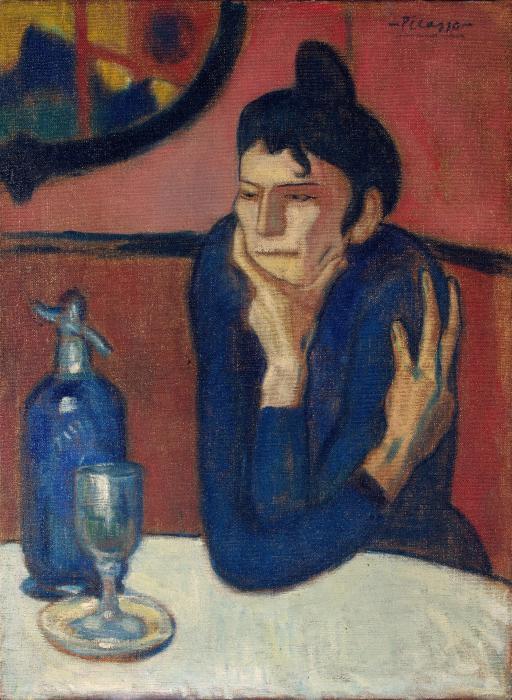Absinthe is a strong alcoholic drink (over 72 degrees), which was prepared on the basis of wormwood with the addition of mint and anise. This cheap alcohol appeared in the eighteenth century and was first popular among ordinary workers because of its cheapness. Then it began to be widely used in bohemian circles. But absinthe is hallucinogenic, it caused aggression and addiction, similar to drug addiction, and severe convulsions. Its use was banned in 1915. Under the brand name "Perno" it is released to the present day.
Painting "Absinthe"
In France, it is believed that the work was first exhibited at the second exhibition of the Impressionists under the name Absinthe. In 1876, some of the Impressionists refused to visit the favorite cafe Courbet "Gerbois", where it was too noisy. They began to meet at the Pigalle dance in the cafe "New Athens". Edgar Degas, the author of the film Absinthe, portrayed his friends - actress Ellen Andre (who in life was a well-groomed woman, served as a model for both Renoir and Gervais, danced in Foley-Bergere) and artist Marcellin Debutin. Debuten squandered his considerable fortune; he did not receive fame as an artist and gradually sank. The work illustrates the mores of Parisian life, raises the problem of alcoholism, which was described by other artists, including the writer E. Zola. The artist did not seek to show life “beautifully”. He allowed the viewer to peer into the realities that surrounded him.
The painting was "Absinthe."
Image analysis
In bohemian Paris, two suffer from loneliness, even being close by. Their faces are gloomy. They have the appearance of people alienated from reality. Both are dressed sloppy, especially a man. He does not look at his companion, his face is puffy from what he drinks regularly. Near the man is a tall glass with mazargan. This drink was used to relieve a hangover. The woman has a dull absent gaze, her shoulders are lowered, her face is pale due to the abuse of absinthe. Legs are ugly stretched forward. She does not follow them, and they are placed out of the blue. Before her stands, apparently, is not the first glass with a dull greenish absinthe. The model breeds it with water from a bottle standing on the next table. Their privacy is emphasized by compositional construction. Degas placed the pair on an inclined plane. This is a tribute to fashion. In Europe, then, everyone was carried away by Japanese engraving with its unusual perspective and surprisingly accurate pattern. In addition, the pair occupies only the right corner of the picture, the other two-thirds are half-empty tables. They have newspapers, matches, an empty bottle. Even with complete solitude, the two still retain the inner closeness of these people. They are united by one thing - loss of hope. The painting "Absinthe" is simply filled with hopelessness, which to a large extent is enhanced by a faded color.
At an exhibition in London
In the years 1872-1873, the painting was exhibited outside the English Channel and aroused the indignation of the well-meaning Victorian public. Degas analyzed the scene without any complacency, with a clear and critical look. Most of all, when considering his work, one recalls the naturalism of E. Zola, possibly of Toulouse-Lautrec. The painting Absinthe is in the Musee d'Orsay in Paris.
Picasso's work
The theme of loneliness, isolation and emptiness in a cafe is not new. In the second half of the XIX century it can be found in the works of Degas and Toulouse-Lautrec. But there was still no sense of drama in the paintings of the young Spanish artist . Picasso has not yet moved to Paris. He is here on short visits from Barcelona. At the age of 22, he was attracted to a popular story related to the general fascination with absinthe. He was given special properties that allow him to awaken the imagination, push him to a new perception of the world and creativity. The painting "Absinthe Lover" by Pablo Picasso has a very strong emotional effect.

Firstly, the plot completely exposes the psychology of a woman. On the face is written a faint semblance of a smile, sarcasm, doom and fatigue. It is immediately clear that the woman’s thoughts are somewhere far away. Here she is absent. Nobody needs her, only absinthe is her friend and comforter. Secondly, color. It is built on the grim contrast of dull red and blue and is comparable to gloomy life conflicts, from which there is no way out. The bluish marble table continues this theme of emptiness, which surrounds the woman in her desperate solitude. The frozen body of a woman only enhances this impression. She cringed all over. The right hand is intentionally changed in proportion, completely completing the oval and turning off the woman from this world. The painting was painted in the fall of 1901 in Paris and is located in the Hermitage.
van Gogh
In 1887, Van Gogh's painting, Still Life with Absinthe, appeared. He is concise.
On the table is a bottle of water and a glass of absinthe. Through the window, a departing person is visible. Perhaps it was he who sat at this table. But another is more interesting. The problem of alcoholism, which faced the artist himself. He himself eagerly consumed this drink, which also causes visual impairment. This leads to the fact that the whole world appears in yellow tones. Perhaps that is why there was a period when the painter predominated in paintings in yellow, especially during his life in the south of France. Passion for absinthe led to
confusion in 1888, when he cut off his ear. The painting is in
the Van Gogh Museum in Amsterdam, Netherlands.
And the conclusion is the simplest.
They come to alcoholism very simply, and the result is terrible.